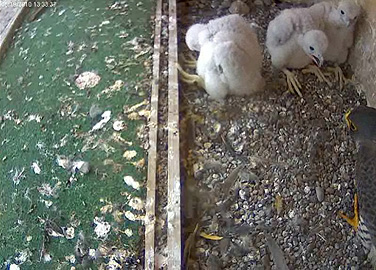News
Growing chicks stymie web watchers

The falcon chicks have grown to be “toddlers,” and soon will be “teenagers.” Photo: UB FALCON CAM
The inquiries have been coming into UB’s home page from as far away as Virginia, Germany and France: Where, oh where, are the falcon parents?
Falcon fans monitoring UB’s Falcon Cam noticed over the weekend that BB and Yankee, parents of the three peregrine falcon chicks nesting in the tower of Mackay Heating Plant on the South Campus, are spending more and more time away from the nest.
“Ok, I sound like a worried mom…and I am. Have I just missed the mama and daddy falcons today? Every time I've checked the chicks, they're alone,” emailed Rebekah from Virginia.
Well, that’s the way it’s supposed to be, according to Connie Adams, senior wildlife biologist with the state Department of Environmental Conservation.
The chicks have grown large enough to “thermo-regulate on their own,” so there’s no need for the parents to sit on the chicks to keep them warm and cool, Adams explains, adding that when the chicks reach this stage they also are getting too big for mom or dad to “brood.”
And as the chicks grow, their demands for food increase as well. “It takes both parents hunting full time to meet the food needs,” she says, noting that food intake is a proportion of body weight, and that most birds need to eat 20 percent of their body weight per day.
While the parents may not be within view of the webcam, at least one of them will always be within sight of the nest, Adams says.
“People need to log off their computers and come in person to see that mom is usually going to be perched on one of those sturdy perch poles out in front of the nest. When the male takes a break from hunting, he will guard the nest and the female will hunt,” she says. “At night, both adults will be right near the nest box.”
Even when the eggs were being incubated, the adult not on the nest would have been right near the box, or have the box within sight; the adults often perch on one of the cornices of the building above the nest box, she says.
“Peregrines are the very definition of protective parents,” she notes.
Some falcon watchers also have noticed that the chicks frequently are out of view of the Falcon Cam. That’s also normal, Adams says.
“These birds become highly mobile right around day 10, so our birds were right on schedule,” she says. “They go from being little white cotton balls to slightly gangly looking, awkwardly mobile 'toddlers.' That is what we have now: toddler peregrines.”
While the chicks now often hug the area right under the camera—and so are out of sight—viewing is about to get much worse, Adams advises. In a week or so, the chicks will begin to make their way toward the front of the nesting box, instead of hanging out in the back.
“When mom or dad returns to the nest, they will rush to meet him/her, and by the time they are four or five weeks old, they will begin to make their way out onto the ledge,” she says. “These ‘teenage’ peregrines will be eager to ‘spread their wings’ and will be doing a serious amount of wing-flapping out of sight of the camera.”
DEC biologists are planning to band the birds on May 25. Viewers of the falcon-cam most likely will not be able to watch the banding. Biologists banding last year’s chicks used a net to snare the birds and banded them inside the tower, which is out of view of the webcam.


Reader Comments
Lisa Delaine says:
Can we name the new chicks LUDWIG, WOLFGANG, FRANZ and JOHANNES after the composers? Thank you.
Posted by Lisa Delaine, Bio major, 06/10/11
lisa delaine says:
The falcon chicks are adorable. I'm watching them constantly. I was wondering how they get water to drink after their meals and what if it rains, can they shelter from the rain?
Posted by lisa delaine, student, biological sciences, 05/26/10